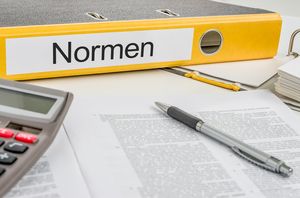KANBrief 1/19

Standards are of crucial importance for machine safety and make a key contribution to preventive activity. They can be used to design work equipment to be safe and ergonomic. Owing to their significance in this respect, the Commission for Occupational Health and Safety and Standardization (KAN) has conducted an analysis to determine whether harmonized standards governing machine safety are still up to date.
Where standards are developed in response to a standardization mandate from the European Commission and are listed in the Official Journal of the EU, they are deemed "harmonized", and give rise to the "presumption of conformity". Users of the standard can presume that by applying it, they satisfy the essential requirements of the EU directives covered by the standard. Where standards are up to date and reflect the state of the art, a high level of safety can be assured.
Machine safety standards are divided into Type A, B and C standards. Only one harmonized Type A standard exists, namely EN ISO 12100 (Sécurité des machines – Notions fondamentales, principes généraux de conception – Appréciation du risque et réduction du risque). This standard sets out basic strategies and conditions that users must observe in order to reduce risk to an acceptable level. Type B standards describe principles of a safety aspect (such as noise, radiation, safety distances) or requirements concerning the conceptual design and construction of a safeguard. Type C standards govern a specific product.
Findings concerning harmonized machine safety standards
The KAN Secretariat has examined Type B and Type C standards more closely with regard to the age of their content. Purely formal updating of Annex ZA (which describes the relationship between the standard and the essential requirements of the relevant directive addressed within it) ensuing from revision of the Machinery Directive in 2006 or owing to translation errors was not regarded as revision of the content.
Statistically, most of the harmonized standards were found to be up to date. This impression was confirmed by random consultations of experts. From an occupational safety and health perspective however, some standards are in need of improvement:
Collisions between mobile machinery and persons continue to occur frequently. These serious accidents are often due to inadequate visibility. The existing standards were not satisfactory and the presumption of conformity for EN 474-1, Earth-moving machinery – Safety, for example, was consequently withdrawn. It was found that the standard governing the operator's field of view on earth-moving machinery (ISO 5006) no longer represented the state of the art (KANBrief 4/16). ISO 5006:2017 was published more recently and represents a substantial improvement in most respects.
Products and workplaces can be designed to be safe and healthy only when the anthropometric data used for their design are consistent with those of the current population. Body dimensions are however subject to continual change. Past updates to standards were prompted primarily by changes in the length dimensions over recent decades. The anthropometric data have however not yet been updated to reflect the recent dramatic changes in the breadth, depth, girth and weight dimensions. DIN 33402-2:2005 and CEN ISO/TR 7250-2:2013 contain identical values from the years 1999 to 2002. Up-to-date body dimensions are urgently needed (NAErg position paper on the anthropometrics situation (pdf)).
Issues also exist outside the area of machine safety standardization: persons must frequently enter vessels or confined spaces in order to perform maintenance or repair work. Often however, the openings of pressure vessels or tanks are barely large enough for persons to climb through them. Should an accident occur and a person have to be rescued from within the vessel, rescuers face a difficult or even impossible task. The reason for this situation is the specification in standards of insufficiently large minimum dimensions for openings (KANBrief 2/13).
We need your help
These examples represent only a small subset of the issue. A further need for improvements may exist of which KAN, or the OSH experts actively involved in standardization work, are not aware. We are therefore relying on you. Please draw our attention to OSH issues which, in your view, are not yet given adequate consideration in standards. Please do so irrespective of the type of standard in question. KAN's task will then be to mediate as a neutral party between the social partners, German state authorities, the German Social Accident Insurance and DIN in order to attain a solution in the interests of occupational safety and health.
Sebastian Korfmacher
korfmacher@kan.de